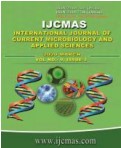


 National Academy of Agricultural Sciences (NAAS)
National Academy of Agricultural Sciences (NAAS)

|
PRINT ISSN : 2319-7692
Online ISSN : 2319-7706 Issues : 12 per year Publisher : Excellent Publishers Email : editorijcmas@gmail.com / submit@ijcmas.com Editor-in-chief: Dr.M.Prakash Index Copernicus ICV 2018: 95.39 NAAS RATING 2020: 5.38 |
Water is an essential commodity for survival and development. But the ever- increasing human population, technological, modernization, changing life patterns and erratic monsoons are likely to lead to water crisis in this millennium. One of the solutions that can be implemented quickly is Water Harvesting. It can be defined as the collection and storage of rainwater for later productive use. The study mainly focused on the water harvesting structures adopted by farmers in dry land areas of Tamil Nadu. The study was conducted in four districts of Tamil Nadu such as Virudhunagar, Ramanathapuram, Sivagangai and Madurai based on the maximum area under dry lands condition. In these locale, the villages were selected by appraisal of several indicators namely rainfall, climate conditions, livelihood analysis and overall agriculture development. Participatory Rural Appraisal methodology was adopted to identify and gather information about the water harvesting practices for water saving. Key informants including progressive farmers belonging to small, marginal and big farmer categories, aged farmers, farm women & farm labourers were involved during the process of data collection. Documentation of water harvesting practices was done using both primary and secondary sources of information. In-depth study was designed by combining descriptive survey and anthropological approach of participatory study. The villagers had developed different water storage techniques/ structures in such a way so that the groundwater as well as rainwater could be utilized properly. Various water conservation techniques/ structures found in the dry land area of Tamil Nadu are farm ponds, tank irrigation system; compartmental bunding and recharge pit etc have been described.
 |
 |
 |
 |
 |